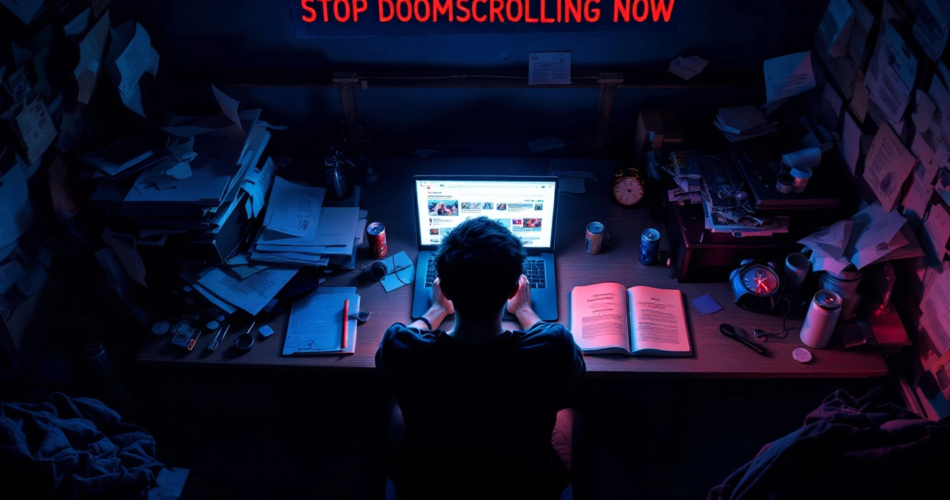Imagine regaining hours of your day, reducing stress, and reconnecting with what truly matters—all by putting your phone down. It might sound too good to be true, but it’s possible. If you’ve ever found yourself endlessly scrolling through bad news or consuming negative content online, you’re not alone. This behavior, known as doomscrolling, can harm your mental health, productivity, and overall well-being. But there’s good news: you can take control and reclaim your life. Ready to get started? Here’s your ultimate guide to stop doomscrolling now.
Table of Contents
- What Is Doomscrolling and Why Should You Stop It?
- Recognizing the Signs of Doomscrolling in Your Routine
- Proven Strategies to Stop Doomscrolling Now
- How to Build Healthier Digital Habits
- The Positive Impact of Breaking Free From Doomscrolling
- FAQs
What Is Doomscrolling and Why Should You Stop It?
Definition of Doomscrolling
Doomscrolling refers to the habit of endlessly scrolling through negative or distressing news and content, particularly online. The term gained traction in recent years as people became glued to their screens during major global events, such as pandemics, natural disasters, or political upheaval. It typically includes behaviors like obsessively checking social media feeds or refreshing news headlines in search of updates.
Negative Consequences of Doomscrolling
The impacts of doomscrolling can be profound. Mentally, it may lead to increased feelings of anxiety, stress, or even depression by immersing you in a stream of negativity. Physically, it disrupts sleep patterns, causes eye strain, and contributes to fatigue. Additionally, the time spent doomscrolling detracts from productivity, leaving you with less energy for tasks that truly matter in your life. Learn more about the effects of doomscrolling here.
Recognizing the Signs of Doomscrolling in Your Routine
Behavioral Indicators
Wondering if you’re doomscrolling? Look for common signs like spending hours scrolling through negative content or feeling unable to set boundaries on your digital habits, even when you recognize how draining it is. These are clear indicators that it’s time to assess your digital consumption.
Emotional and Physical Impact
If you frequently feel exhausted, overwhelmed, or emotionally drained after extended screen time, it’s likely a result of doomscrolling. Physical symptoms such as tension headaches, eye strain, or uncomfortable posture can also result from excessive hours spent glued to your device. For more tips, read Signs You May Need a Digital Detox.
Proven Strategies to Stop Doomscrolling Now
Set Time Limits on Social Media Apps
Modern smartphones offer time-management tools like Screen Time on iOS and Digital Wellbeing on Android. Use these features to track your usage and set limits for specific apps. You can also schedule timed breaks to remind yourself to disconnect.
Use Positive Reinforcement Techniques
Reward yourself when you stick to healthier habits. Whether it’s indulging in a favorite activity or spending quality time with loved ones, small rewards can make the process of changing your behavior more enjoyable and sustainable.
Stay Mindfully Engaged
Replace doomscrolling with more positive activities such as reading, journaling, or practicing meditation. These practices not only redirect your focus but also promote mental clarity and relaxation. Learn mindfulness techniques here.
How to Build Healthier Digital Habits
Schedule Phone-Free Hours
Dedicate certain times of the day to being phone-free, such as during meals or in the hour before bedtime. Creating boundaries like these can dramatically improve your mental health and productivity.
Curate Your Online Environment
Take control of what you see online by unfollowing accounts or sources that cause stress or anxiety. Instead, prioritize uplifting and positive content to make your digital space a source of encouragement. Check out our guide on How to Set Realistic Goals for Breaking Bad Habits.
Seek Professional Help if Necessary
If your doomscrolling habits feel impossible to break, or if they’re associated with deeper mental health issues, don’t hesitate to consult with a professional. Therapists and counselors can offer guidance and support in creating healthier routines.
The Positive Impact of Breaking Free From Doomscrolling
Regained Time and Productivity
Eliminating doomscrolling from your routine opens up time for meaningful activities like exercise, hobbies, and spending time with loved ones. Before you know it, you’ll be amazed at how much you can achieve.
Enhanced Mental Well-being
By stopping the habit, you’ll likely feel more focused and experience reduced anxiety and improved sleep. The benefits for your mental health are significant and long-lasting. Read more about managing screen time at this resource.
Strengthened Real-World Connections
Breaking free from excessive scrolling allows you to reconnect with loved ones, have deeper conversations, and nurture real-world relationships that may have taken a backseat to your screen time.
Frequently Asked Questions
What is doomscrolling, and how does it affect mental health?
Doomscrolling is the act of constantly consuming negative news or distressing content online. It can trigger anxiety, stress, and even depression over time.
How can I stop doomscrolling now without quitting social media completely?
Set time limits, curate your social feeds, and replace scrolling with positive activities like reading or mindfulness practices.
Are there apps that help in fighting doomscrolling habits?
Yes! Apps like Moment, Forest, and Habitica can help you stay mindful of your screen time and develop better habits.
What are some physical signs of doomscrolling?
Physical symptoms include headaches, eye strain, and poor posture resulting from extended time spent staring at a screen.
What long-term benefits can I expect from breaking free from doomscrolling?
Some benefits include reduced anxiety, better sleep, improved productivity, and stronger relationships.
Conclusion
Doomscrolling may feel like a hard habit to break, but with awareness and consistent effort, you can reclaim your time and mental bandwidth. By setting boundaries, building healthier digital habits, and staying mindful of your online consumption, you can lead a more balanced, fulfilling life. Ready to start today? Share this guide with friends and family who need it, and take that first step toward freedom. You’ve got this!


